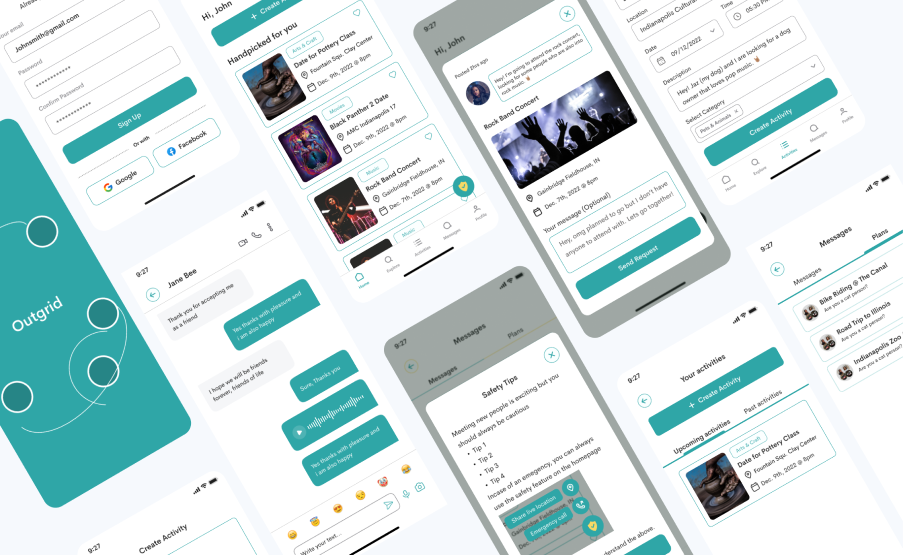
INTRODUCTION
In a time when technology seamlessly intertwines with our societal fabric, social computing emerges as a pivotal tool to address pressing global challenges. This project's mission was clear: design a social computing system tailored to tackle a significant human-centric issue. The solution had to embody and elevate social practices, be it through interaction, communication, or collaboration.
PROJECT OVERVIEW
In our digital age, social media platforms promise global connections at our fingertips. But does this digital closeness translate to genuine human connection, or does it paradoxically distance us further? For my Master's project, I delved into this contemporary conundrum: Does social media truly bring us closer, or is it pushing us apart?
DESIGN PROCESS
Followed the human-centered design (HCD) process to investigate the intricate relationship between social media and human connection, aiming to unravel the layers of our online interactions.

RESEARCH & ANALYSIS
Academic Findings
As our daily activities move online, the opportunities for physical human interactions decline. Despite social media's promise of connectivity, Waytz & Gray (2018) posit that online platforms might unintentionally widen social gaps due to inherent anonymity. Unlike these, face-to-face interactions allow richer emotional exchanges. For young adults, there's a nuanced relationship with social media: it can heighten loneliness when used as a substitute to physical interactions but can alleviate it when enhancing offline bonds (Nowland et al., 2017). Also, a Cigna study highlights young adults' increased vulnerability from heavy social media use.
Primary Research
Our interview sample consisted of a mix of students, young working professionals, introverts and extroverts. This was to understand how the problem mentioned above affects people differently. Across these participants, we found that:
- Offline friendships are valued for their richness.
- Relationships on social media are more beneficial when they are used to complement existing relationships
- Despite using social media to enhance existing relationships, people do activities in person to strengthen their bonds.
- Social media is beneficial in finding new people and keeping up with friends, but it does not remove the need for physical interactions.
COMPETITIVE ANALYSIS
Various offline and online strategies have been adopted to tackle the challenge of diminishing real-world interactions. Offline, individuals turn to pet adoption, community engagements, regular exercises, or opting for co-working spaces. Online platforms like 'Nextdoor' aim to unite local communities. However, these solutions are not without their limitations:
THEIR LIMITATIONS
Offline Approaches
While beneficial, they often depend on individual preferences and can miss addressing the broader community's needs.
Digital Platforms (e.g., Nextdoor, Meetup)
While they bridge communities with Nextdoor, users have found it commercialized and, at times, promoting extremist views. As for Meetup, It charges for group formation and promotes events with limited availability. The platform's forum-style chat doesn't foster close relationships, and the lack of profile verification poses security concerns for in-person events.
The current landscape underscores a pressing need for a more integrated, safe, and personalized approach.
THE SOLUTION
After multiple ideation sessions, we developed a social media platform focused on fostering genuine, in-person connections. At its core:
Discovery & Engagement: Users post activities they're interested in (like dog walking or hiking). Based on shared interests, these posts are suggested to potential matches.
Activity Matchmaking: Interested users send a request with a brief introduction. If mutual interest exists, they form a group to discuss and plan the activity.
Safety First: The platform emphasizes safety with online features like profile verification and a two-way rating system. Offline safety is bolstered by sharing live locations and an SOS feature for emergencies.
Our design brings spontaneity back into social interactions while ensuring members' safety and genuine connections.
USER TESTING
Cognitive Walkthrough Summary
Objective:
Evaluate the app's intuitiveness and identify areas with usability challenges for new users
Process:
Started by defining the tasks that we expect users to perform. In this case, it was; creating an activity to share with people, finding an activity of interest, and sending a request to the post owner. We accessed the buttons and steps users must take to act and answered some questions about the outcome.
Key Findings:
Some UI elements were not visible enough and could be easily missed by users.
Some elements needed to be organized better to avoid confusion.
Some screens were unnecessary e.g Invite screen,
CONCLUSION
Recommendations:
- Prioritize the "Create New Activity" button by relocating it to the home screen for increased visibility.
- Streamline messaging, allowing direct communication from the notifications screen.
- Integrate custom messaging with activity requests for richer context.
- Implement distinct "Messages" for pre-activity discussions and "Plans" for post-acceptance group chats.
- Eliminate the "Invite" feature, simplifying user interactions and enhancing security.
Outcome:
Iterative changes based on this feedback made our app more user-centric and intuitive.